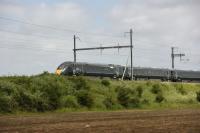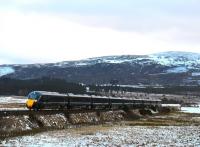News - Class 800
| Contact the news and picture editor. |
|
Themes ScotRail Trains Scottish Rail Holdings Nationalisation CMAL Caledonian MacBrayne ScotRail Politics Tyne and Wear Metro RMT ORR Fares Accessibility Hospitality Ticketing COVID-19 Class 800 Recruitment
|
The Office of Rail and Road (ORR), the economic and safety regulator of Britains railway, has made several recommendations from its review of how the rail industry responded to the potential safety issues leading to the withdrawal of Hitachi Rails Class 800 series trains in May last year.
(Permalink) Class 800 ORR 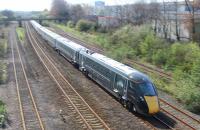 Margam Halt: Nice day in Wales and couldn't resist another few shots of 5X20.
5X20 made up of 2 x IEP Class 800's the leading set in GWR livery passing the site of Margam Halt with a Bristol Parkway to Swansea ... 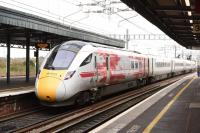 Didcot Parkway: The new Class 800's are now out and about, some on crew training and others on passenger duty in the GWR livery. I assume they are now giving a full rake of vehicles one nmber as on this unit, seen he ... |
|
An investigation said a type of aluminium used under some of the trains may have been vulnerable to being damaged by 'salt-containing' substances. The cracks caused weeks of travel chaos.
(Permalink) Class 385 Class 800 Cracks Fatigue Cracks ORR 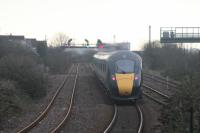 Port Talbot Parkway: GWR Class 800 Electro-diesel set 800011 on the rear of the 1029 Swansea to London Paddington service departing Port Talbot on 16th November 2017
 Margam Halt: Nice day in Wales and couldn't resist another few shots of 5X20.
5X20 made up of 2 x IEP Class 800's the leading set in GWR livery passing the site of Margam Halt with a Bristol Parkway to Swansea ... |
|
The Office of Rail and Road (ORR) today reports in its interim review that Hitachis Class 800 and 385 series trains were affected by stress corrosion and fatigue cracks. These resulted in a significant number of Class 800 trains being withdrawn from service in May.
(Permalink) Class 385 Class 800 Cracks Fatigue Cracks ORR |
|
The Office of Rail and Road is undertaking a review to understand the lessons the industry can learn from the discovery of cracks on Hitachi Class 800 and 385 series trains.
(Permalink) Class 385 Class 800 ORR 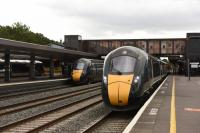 Oxford: Two GWR Class 800 IEPs, 800-028 and 802-003, in Oxford station on 6th August 2019.
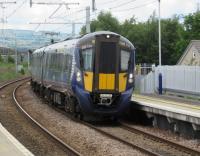 Camelon: If it were human, only a mother could love it. A Class 385 pulls into Camelon with a Glasgow to Edinburgh service on 6 June 2019. |
|
Hitachi Rail, train operators, and government have agreed, with oversight from the Office of Rail and Road, a service recovery plan to safely reintroduce more 800 Series and 385 Series trains to the network.
The fleet of 800 series trains was removed from service as a precaution at the weekend when cracks were found on some trains. Following extensive safety checks on their trains, Transpennine Express, Hull Trains and ScotRail have been able to operate services across all of their routes since last weekend. (Permalink) Class 800 Hitachi Rail |
|
Disruption to Scotland-London rail services due to cracks in trains is expected to continue for weeks.
(Permalink) Cancellations Class 800 GWR Hairline cracks Hitachi LNER |
|
Passengers on Britain's intercity rail services face a third day of disruption as engineers continued to check high-speed trains for cracks. Trains between London and the south-west and between London and Scotland on the East Coast line are affected.
(Permalink) Cancellations Class 800 GWR Hairline cracks Hitachi LNER |
|
Rail passengers in parts of the UK are continuing to experience delays after a number of high-speed trains have been removed from service due to hairline cracks.
(Permalink) Cancellations Class 800 GWR Hairline cracks Hitachi LNER |
|
Hitachi apologises after cracks found in some of its trains lead to services being cancelled. [See also item on 27/04/2021 and the Railway Magazine of 03/05/2021.]
(Permalink) Cancellations Class 800 GWR Hairline cracks Hitachi LNER 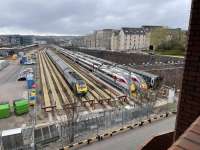 Clayhills Yard: Saturday's 07:52 & 09:52 LNER Azuma trains parked up at Clayhills due to cracks being found in the Class 800 bogies. |
|
Rail passengers are being told to cancel travel plans after a number of high-speed Scotland-London trains had to be taken out of service as a 'precautionary measure' when hairline cracks were found.
(Permalink) Cancellations Class 800 GWR Hairline cracks Hitachi LNER |
|
Cracks were discovered during routine maintenance of two Hitachi 800 trains.
(Permalink) Class 800 GWR Hairline cracks Hitachi |
|
The Class 800/801/802 inter-city trainsets supplied and maintained by Hitachi are to be fitted with a new generation of brake pads and discs which has been developed by Knorr-Bremse to improve brake system performance and reduce life-cycle costs by facilitating longer maintenance intervals.
(Permalink) Class 800 Class 801 Class 802 Hitachi Knorr-Bremse |
|
InterCity East Coast operator LNER has received approval for its Class 800 Azumas to enter passenger service, conditional on final testing being completed. The Office of Road and Rail has written to manufacturer Hitachi Rail Europe, giving authorisation for theRead more
(Permalink) Azuma Class 800 Hitachi LNER |
|
More than 10,000 extra seats will be available to Great Western Railway passengers on January 2, compared with the same number last year.
(Permalink) Class 800 GWR Great Western Railway |
|
Thirty-two of 36 five-car Class 800s in traffic with GWR.
(Permalink) Class 800 GWR Great Western Railway |
|
The latest generation of Intercity Express trains arrived at the Inverness depot for the first time yesterday ahead of its introduction later this year.
It is hoped that Hitachi's 'train with a brain' will offer greater comfort, shorter journeys and be much kinder to the environment while its on board computer will make it safer. Designated the British Rail Class 800, it incorporates technology from Japan's famous 'bullet trains' and is part of the UK government's £5.7 billion Intercity Express Programme. (Permalink) Class 800 Hitachi Inverness |
|
A world first will take place in Yorkshire next month to celebrate the heritage and future of one of the country's most iconic railway lines.
Four trains spanning four generations will travel side by side, in the same direction, along the East Coast Main Line on April 23 2017. Yorkshires DNA of speed and style through the ages binds together an event that fittingly comes just days before the now legendary Tour de Yorkshire begins. This will be a once in a lifetime opportunity to see the world famous Flying Scotsman travel alongside two trains from Virgin Trains revitalised fleet - an HST (Class 43), an InterCity225 (Class 91) - and the rail operators brand new train, the Virgin Azuma (Class 800) which is being built by Hitachi in the North East, and will come into service in 2018. The four trains will travel together for several miles north of York to showcase the past, present and future of rail travel. (Permalink) Class 43 Class 800 Class 91 Flying Scotsman HST |
|
The Digital Railway programme has hit a major milestone as Hitachi Rail Europe began testing digital technology on its Intercity Express Programme (IEP) trains, set to enter passenger services on the Great Western route from next year.
The intercity trains are fitted with digital signalling designed to boost capacity and relieve overcrowding as part of the DfTs ambitious Digital Railway programme. A Class 800 train (800 802) has now entered testing stage at Network Rails signalling facility ENIF, in Hitchin. (Permalink) Class 800 Hitachi |
|
MTU, a division of Rolls-Royce, will continue supplying PowerPacks for the Hitachi trains used on the Intercity Express Programme (IEP) after a new long-term contract was announced today.
The company will provide additional MTU Series 1600 PowerPacks on top of 250 packs it was originally contracted to deliver for the Class 800 and 801 trains in 2012. It will also assume responsibility for their maintenance “ both preventative and any repairs or major overhauls “ from 2017, under a contract set to last the 27.5 years of Hitachi's service and maintenance contract for the IEP. (Permalink) Class 800 Class 801 Hitachi MTU Rolls-Royce |
|
A trainbuilder has tested its new train on North-East lines for the first time, The Northern Echo can reveal.
Hitachi Rail Europe has driven rolling stock on tracks at Newton Aycliffe, County Durham, in a move bosses say represents a landmark moment in their £82m venture. The engine, a Class 800, will eventually deliver services on the East Coast and Great Western lines as part of the Governments InterCity Express Programme (IEP) to revamp high-speed routes. (Permalink) Class 800 Hitachi |
|
First TransPennine Express Ltd has awarded Hitachi Rail Europe and leasing company Angel Trains a contract to supply 19 five-car AT300 electro-diesel multiple units for use on the TransPennine Express franchise in northern England from December 2019.
The contract was announced on March 31, the day before the new TransPennine Express franchise starts. FirstGroup said the AT300 would be 'amongst the most advanced inter-city trains in the UK', and 'completely remodel the experience of train travel in the North'. The AT300 trainset will be 'closely related' to the Class 800 electro-diesel trainsets being supplied under the Department for Transport's Intercity Express Programme, but to cope with the gradients on the TransPennine network they will utilise higher engine operating power, and be equipped with larger fuel tanks and brake resistors. They will have a service speed of 200 km/h, but with the capability for running at 225 km/h subject to the provision of suitable infrastructure. (Permalink) AT300 Class 800 First TransPennine Express Hitachi |
|
The first Virgin Trains East Coast IEP (Intercity Express Programme) train passes through Hampstead Heath station on the North London Line after having attended a media event to launch these trains at London Kings Cross station.
Virgin Trains East Coast are marketing these trains as Azuma. which is Japanese for 'east'. The trains are part of the Hitachi A-Train family, most of them will be built in northern England. The A-Train design concept includes several elements, the core features being that the vehicle car bodies (walls, roof, floor) are constructed from double skin aluminium extruded sections which are friction stir welded and the hollow extruded mounting rails on the vehicle body to which modular components can be attached. Class 800 trains will travel on the East Coast Main Line between London Kings Cross and Scotland, plus the Great Western Main Line between London Paddington station and South Wales. They are electro-diesels which collect power from overhead wires when available and use onboard diesel traction when travelling on non-electrified sections of railway. (Permalink) Azuma Class 800 Hitachi Virgin Trains |
|
The first overhead wires of the Great Western Main Line electrification project have gone up near Reading.
Network Rail engineers began the installation on November 12 between Pangbourne and Tilehurst - the section which will be used by Hitachi to test its Class 800 Intercity Express trains. A mile of earth wire was installed, becoming the first section of OLE to go up beyond the existing catenary at Airport Junction in Stockley, London. (Permalink) Class 800 Hitachi |
|
This is what the new electric trains should look like when they run between London and Swansea.
The Hitachi Class 800 express train will run on the south Wales to London road when the electrification programme is completed in 2018. This computer-generated video and still images show what the trains will look like. (Permalink) Class 800 Hitachi |
|
The first of 122 225km/h Super Express Trains (SETs) ordered by Britain's Department for Transport (DfT) as part of its Intercity Express Programme (IEP) left Hitachi's Kasado plant in Japan on January 7 by ship on the first leg of its journey to Britain.
The five-car bi-mode class 800 train is due to arrive at the port of Kobe on January 22 and will be transferred to a larger vessel for the remainder of its sea voyage to Southampton in southern England, where it will be unloaded in March. Trials are due to begin on the Old Dalby test track near Nottingham in April and the test programme will be managed by Hitachi Rail Europe. Three pre-series SETs and the first 10 production trains will be built in Japan before assembly switches to Hitachi's purpose-built £82m Newton Aycliffe plant in northeast England, which will assemble the remaining 109 trains. (Permalink) Class 800 Hitachi |
|
A £1.2bn deal to build new UK trains has been won by Hitachi Rail Europe.
The firm will build 270 carriages at a new factory in Newton Aycliffe, County Durham, which will start production in 2016. The carriages are part of the class 800 series and will go into operation on the East Coast Main Line from 2019. (Permalink) Class 800 Hitachi 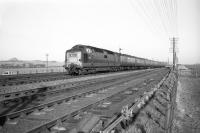 Drem: A Deltic at speed with a Kings Cross - Edinburgh train on the ECML near Drem in the 1960s. North Berwick Law stands in the left background. 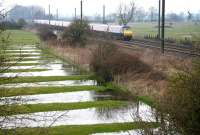 Tollerton: The up 'Flying Scotsman' hurries past flooded fields on the approach to Tollerton, approximately 10 miles north of York, on 25 March 2010. 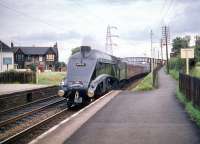 Joppa [2nd]: With only three miles to go, the non-stop London - Edinburgh 'Elizabethan' passes through Joppa on a fine summer's day in August 1959. The locomotive is one of Kings Cross shed's corridor-tende ... |
|
The Digital Railway programme has hit a major milestone as Hitachi Rail Europe began testing digital technology on its Intercity Express Programme (IEP) trains, set to enter passenger services on the Great Western route from next year.
The intercity trains are fitted with digital signalling designed to boost capacity and relieve overcrowding as part of the DfTs ambitious Digital Railway programme. A Class 800 train (800 802) has now entered testing stage at Network Rails signalling facility ENIF, in Hitchin. (Permalink) Class 800 Hitachi |
